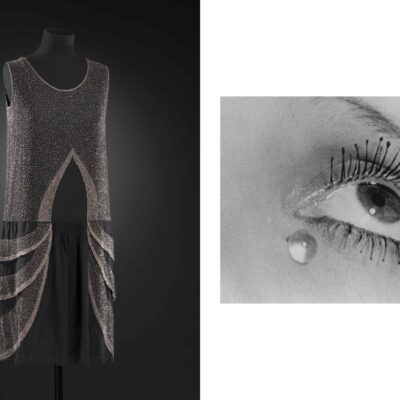
Exhibitions 13.07.2023
18.07.2023
1920sEuropean fashionfashion exhibitionfashion photographySurrealism
Other extraordinary objects – and the stories they represent – featured in the exhibition Mar Ray and Fashion at MoMu, Antwerp.
The body, and the female body in particular was one of the main subjects of Surrealist art. Metamorphoses and transformation, the body in pieces, alteration of the proportions to suggest connections between the fleshy body, other symbols and imaginary environments are some of the tropes used by artists to deploy their view of the world.
Being the ground zero of fashion, the body is central also in the designs and productions of fashion, and particularly in the 1930s the female body acquired a new status as it was liberated by understructures reshaping it and it was clad in bias-cut ensembles, suggesting a more sensuous and revealing approach to natural, unruly, desirable shapes and forms.
Amongst all the body parts that lend themselves to the creative and cerebral explorations of Surrealism, hair is surely the most fascinating. It is also the one that both surrealist art and surrealist fashion used to trick the eye and play with the uncanny.
In 1929, Man Ray photographed a woman with her head hanging back, her long blond hair falling freely on her back. The iconic image became a staple of the marriage between artistic depiction and the possibility to apply surrealist grammar to fashion design.
Indeed, a few years later, Elsa Schiaparelli featured a drawing by Jean Cocteau in one of her creations belonging to the 1937 Autumn-Winter collection: an evening jacket made of ecru linen, which on the front features a woman’s profile whose hair – made of embroidered bugle beads – flow back, waving over the right sleeve.
The influence of the image, as well as that of the creation by Schiap and Cocteau, continued in Olivier Theyskens’ Spring-Summer 1999 collection. Here, the Belgian designer reproduced the same hair motif on the back panel of a jacket, creating a trompe-l’oeil effect and visually mixing the mane of the wearer with the shiny, long blond locks carefully embroidered on the jacket.